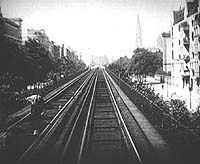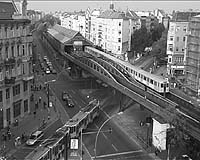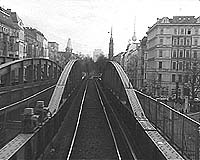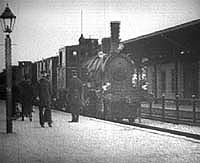reconstruction_deconstruction
Screening May 23. at 9 PM in
Z-bar cinema.
film by stefan schuster,
max and emil skladanowsky
sound by silb
with an introduction by
christa blümlinger
Critic in the Berliner newspaper Taz 23. Mai 2002
rec the use of found footage material is a widely employed method of working in the fields of art film and experimental film. throughout this practice, existing film material is modified, leading to different formal and contextual meanings. in some cases, it is difficult to find the original film footage or to gain access to it. with old film footage there is sometimes only one copy existing or even only single frames. the reminiscences of old film footage suggest that the film did once exist in its entirety, but is now lost. the film berlin:schönhauser is based on film material created by max and emil skladanowsky in 1896 and available now only in single frames. the skladanowsky material produced the starting point for berlin:schönhauser in a different way from that of the conventional found footage film process, in such as it is only referred to as an idea, without using any material directly because of its non-existence.
_ images of rail tracks, trains and/or images taken from riding trains were used often at the beginning of filmmaking. in this context, the film "arrival of the train" by the brothers lumière (arrivée d'un train à la ciotat, 1895) has become an archetypal example in the history of film. shortly after the lumiéres, max and emil skladanowsky shot almost the same scene of an arriving train in berlin (einfahrt eines eisenbahnzuges, 1896). we find, at the pioneer stage of film history, an aesthetic link between film and trains. further works by lumière and the skaladanowsky brothers (eine hochbahnfahrt durch berlin, high track train through berlin, 1896) continue to show this close relationship. we find in these early works an emerging identity with a technical momentum, an experience that is immanent in both film and train. both technologies employ a method in which speed generates the passing of images in front of the passenger/audience, through the moving train: the landscape, and through the film: image frames.
dec at the first showing of the film "arrivee d'un train a la ciotat" in paris, 1896, the audience panicked and ran out of the theater. it is very likely that the same occurred in berlin when the skladanowskys showed their film. that the first experiences of moving pictures created a shock of perception in the audiences of that time is a well-documented phenomenon; although, it is not clear whether they fled an imaginary reality or were shocked by the illusion of movement never seen before. in any case, it is certain, with the moving images of the arriving train, a totally new form of presentation appeared, "arrixved" in the 20th century.



